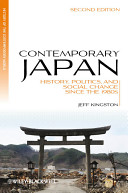Comprehensive, well-researched, and well-written.
The book is a little inaccessible due to its high price which is too high for a college student.
The book entitled “Contemporary Japan: History, Politics, and Social Change since the 1980s” is a piece of writing chronicling and comprehensively examining the causes of the Japanese economic bubble in the late 1980s and the effects of the recent financial collapse. This is one of the few books to probe and examine the depth and profundity of the crisis in the country since Emperor Hirohito passed away, the Cold War closed, and the economy went down the drain. It attempts to assess the dramatic political revolution of the country in 2009. It analyzes how risk has stepped up in the country that resulting to the undermining of the sense of security and the causing of greater disparities in society. It makes an assessment of the country’s record in the environment, the results consequent to their neo-liberal reforms, policies on immigration, their society composed more and more of older people, their alliance with the United States of America, their imperial family, and the “yakuza” criminal gangs. Choice Magazine, a review publication claiming to be a prime source for reviews of academic books, electronic media, and Internet resources of interest to those in higher education (CHOICE, 2014), selected this book as the 2011 Academic Title.
Every January issue Choice Magazine publishes its own list of the best scholarly titles it reviewed. It is a very selective list. Winners go through a long, tedious and critical process before being selected. Each year the Magazine reviews approximately 7000 books. Out of that several thousand, ten percent are selected to be awarded the Outstanding Title. The criteria for choosing included: overall excellence in its scholarship and presentation, importance that is relative to other literature in the field of the writing, distinction as a first treatment of a given subject in book or electronic form, originality or uniqueness of treatment, value to undergraduate students, and importance in building undergraduate library collections (CHOICE, 2014).
Jeff Kingston is the author who wrote the book “Contemporary Japan: History, Politics, and Social Change since the 1980s”. He is a professor of History and Director of Asian Studies at Temple University Japan Campus. He wrote many books such as “Japanese history and Japan’s relations with Asia”, “Transformation 1952-2000 (2004)” and “Japan’s Quiet Transformation: Social Change and Civil Society in the 21st century (2005)”. His areas of expertise include the political economy and social history of modern Japan, modern Southeast Asia, regionalism in Asia, conflict and reconciliation, and law and social change. This professor contributes editorials and reviews to the International Herald Tribune, Wall Street Journal, Financial Times, Japan Times and Bangkok Post. Frequently, he is interviewed by The BBC, CNN, Bloomberg, CBS, ABC, Time, Newsweek, AFP, AP, NHK, Asahi Shimbun and Voice of America and other media networks and organizations (Temple University Japan Campus).
His interests in research include studies that focus on contemporary Japan; civil society; law and social change; migration; trafficking, minorities and East Timor. He has recently published a couple of books that critically probe and examine sweeping major social change in Japan during contemporary times. He assesses again the so-called Lost Decade of the 1990s, focusing on the transition to the rule of law, judicial reforms, freedom of information and transparency, and the role of the media and the growth of civil society organizations. Currently, his studies involve researching the public discourse, anxieties and agendas involving the demographic time bomb and what this means in terms of families, working women, the elderly and foreign workers. He has recently published articles on the political economy of public works in Japan, compensation for colonial lepers, Uighurs in China, terrorists in Kyrgyzstan, and justice and reconciliation in East Timor (Temple University Japan Campus).
Biographical entries of his representative publications include (Temple University Japan Campus):
• Kingston, J. Balancing justice and reconciliation in East Timor. Critical Asian Studies, vol. 38, no. 3 (Sept. 2006), 271-302.
• Kingston, J. 2006. Kokka saisei [in Japanese]. Hayakawa Shobo.
• Kingston, J. 2006. Regaining dignity: Justice and reconciliation in East Timor. Brown Journal of World Affairs. Volume 13, issue 1, Fall/Winter 2006 (227-240).
• Kingston, J. 2005. Compensating colonial lepers, slave laborers and hibakusha: Troubling legacies and evolving standards of postcolonial Justice in Japan. Japan Focus, November 2005.
• Kingston, J. 2004. Japan’s quiet transformation: Social change and civil society in the 21st century. RoutledgeCourzon.
• Kingston, J. 2001. Japan in transformation 1952-2000. Longman.
He belongs to the editorial advisory boards of Japan Focus and Critical Asian Studies (Temple University Japan Campus).
The Asia-Pacific Journal: Japan Focus is a thorough and in-depth critical analysis of the forces shaping the Asia-Pacific and then the world. This Journal associated with the author seeks to shed light on the geopolitics, economics, history, society, culture, international relations and forces for change in the modern and contemporary Asia-Pacific (The Asia-Pacific: Japan Focus, 2014).
Critical Asian Studies (formerly the Bulletin of Concerned Asian Scholars) is a peer-reviewed quarterly journal that welcomes unsolicited essays, reviews, translations, interviews, photo essays, and letters about Asia and the Pacific, particularly those that challenge the accepted formulas for understanding the Asia and Pacific regions, the world, and ourselves. Its mission is to develop a humane and knowledgeable understanding and illuminating of Asian societies and their efforts to maintain cultural integrity and to confront such problems as poverty, oppression, and imperialism, and to create substitutes and alternatives to the prevailing and enduring trends in scholarship on Asia, which too often spring up from a parochial cultural point of view and serve selfish interests and expansionism (Critical Asian Studies, 2014).
Jeff Kingston completed Bachelor of Science in Columbia University, School of Foreign Service in 1979. He obtained a Master of Arts degree in International Affairs in Columbia University School of International Affairs in 1981 and a Doctor of Philosophy in History in Columbia University in 1987 (Temple University Japan Campus).
“Contemporary Japan: History, Politics, and Social Change since the 1980s” has an International Standard Book Number (ISBN) of 978-1-4051-9194-4. It has 324 pages. It was first published in July 2010 by Wiley-Blackwell. What this reviewer is going to review is the Second Edition of the book (ISBN 978-1-118-31507-1) first published on 2013. (The differences in content will be discussed in the coming chapters.)
On Wiley.com, the hard cover version book is sold at $103.95. The electronic copy is sold at $27.99. This is a somewhat inaccessible book because of its price. When converted to Philippine pesos it is approximately P4573.8 and the e-book version would be approximately P1231.36. For Filipino undergraduate students, this is a huge jackhammer to the wallet.
The book to be reviewed “Contemporary Japan: History, Politics, and Social Change since the 1980s” is part of the History of the Contemporary World Series published by Wiley-Blackwell. The said series gives an historical point of view on the development and maturation of the contemporary world. Each book of the series examines a particular country, region or a global theme as it has evolved and grown in the recent past. The focal point is first and foremost on the period beginning in the 1980s. However, the authors of the books of the series will provide more thorough or deeper context when they see it necessary for the delivery of the thesis of the books. The books are first and foremost written in an historical framework of analysis. However, the books promise to be written for an audience of varying disciplines and fields of expertise. The books assume no prior knowledge on the part of the readers (Wiley, 2014).
For this book review, this reviewer would ultimately like to evaluate how the book has tried to fulfill its promise in imparting valuable knowledge to the ignorant reader of contemporary Japan. It will examine the style of writing, format, and the progression of topics of the book and its implications on the fulfillment of its said promise.
In the Part One, the book first told of Japan ’ s recovery from the devastation of the Second World War that left its cities, towns and factories in utter ruins was very surprisingly speedy, but no one in the late 1940s could have anticipated that its economy would one of those days become the second largest in the world. After World War two in the country, there was massive migration from rural areas and places to the cities, because of being pulled by the lure of jobs and dismayed by the few and limited opportunities of small – scale farming. The spreading out of the mass media, especially television, helped bring up a strong sense and idea of nation even as open exhibitions of nationalism remained to be a despicable act and a taboo, tainted by war. While the country’s neighbors may have looked at the continuing presence of the US military reassuring and comforting, its citizens have remained split up and not sure about this likely usurpation on their sovereignty.
Later in Part One, the book told about Japan’s Lost Decade which began in the early 1990s and that the certain grip of economic stagnation has persisted for a couple more decades and that there are only little signs it will cool off anytime soon.
In Part two it told about the key features of the demographic time bomb that include the Japanese having fewer children, the graying of the baby boom cohort (1947 – 9), and the elderly living longer. The country is one of the most rapidly aging societies in the world. Based on current patterns, by 2040 the people over 65 will outnumber the young by four to one.
Next told in Part Two is that the family in Japan invokes images of stability that are more and more out of step with emerging realities. The country’s social welfare system is to a considerable degree dependent on the family to give critical support, assistance, and resources to family members in need.
Later in Part Two the book reported of the fading of stable and secure employment patterns and the increase of less stable and riskier non – regular employment practices as one of the dramatic upheavals reverberating through contemporary Japan. The problems of this society of greater disparities call for a major challenge to policy – makers and national identity. Given the existing norms that value corporate paternalism and lifetime employment, rapid deregulation in the job market has had unanticipated consequences that are weakening the implicit social contract.
In Part Three the author wrote about the Japanese political system being in crisis because the people have lost faith in the politicians and trust in government. During the 2009 elections the political parties discovered that widespread anxieties about growing disparities and social cohesion carry political consequences. There were also encouraging signs of reform in Japanese politics other than government change and the advent of party competition as seen by the emerging cosmopolitan young leaders.
Still in Part Three the author reported that security concerns are still not diminished with the end of the Cold War in 1989 despite high expectations. After the death of Emperor Hirohito (Heisei Era) there were growing anxieties concerning China’s massive growth in defense spending and modernization of its armed forces, and North Korea’s missile tests and nuclear weapons program. Japan has constrained its security initiatives because of their known military rampage through Asia, however some want to shrug off the past and believe that increasing security is normal and congruent to national interest.
Next, the author wrote about Japan pertaining to environmental issues. In 2009, Prime Minister Yukio Hatoyama made a bold offer of cutting Carbon dioxide emissions by 25 percent by 2020 from 1990 levels in an effort to regain a leadership role on the environment that Japan has relinquished since the launching of the 1997 Kyoto Protocol. This nation brought us the Kyoto Protocol and the Prius hybrid car produces only 4 percent of global CO2 emissions compared to 20 percent each for the US and China.
Next the author reported of the rapid increase in the number of immigrants to the country during the Heisei era which increased anxieties among its citizens about the future of their country, national identity, and how to manage the influx. There are practical reasons to accommodate more immigrants on more favorable terms fighting ingrained concerns about the implications of a larger non – Japanese population. Migrants have been recruited during the Heisei era migrants because of labor shortages, which included both unskilled and skilled workers. The country has become more diverse and is to a degree a multi – ethnic society in denial. This has become a touchy issue and a divisive topic that circumvents consensus. There were lesser people who welcome immigrants thus giving the danger of labor shortages and fewer taxpayers to maintain the national medical and pension programs.
Lastly in Part Three, the writer talked about Japan’s war memory that is painful and divisive in any society and especially so when they consider themselves responsible for the crimes and atrocities.
The chapter examined war memory and responsibility during the Heisei period by focusing on the Yasukuni Shrine, a Shinto religious site in Tokyo that symbolized the nexus of imperial expansion, militarism and the emperor’s cult during the war years and the Asia Women’s Fund which refers to the comfort women. These were called awkward talismans The shrine was controversial because it symbolized the cause of the atrocities during the war, many propose to keep the shrine because they deem the expansion projects of Japan in the past as just, at a time when a whole nation bereaves and takes responsibilities for the brutalities that happened. The Asia Women’s Fund proved that the it was not known that there were comfort women during the war, not known until the 1990s!.
Part Four discusses institutions in peril. One is the imperial family’s reduction into a symbolic institution. Emperor Akihito during Heisei has accepted war responsibility and made considerable gestures towards atonement.
Later in Part Four, the writer talks about Japan’s equivalent to New York and Italy’s Mafia. The Yakuza are controlling various illegal and profitable rackets from drugs and prostitution to gambling, blackmail, loan sharking, and extortion based on their core strengths in violence and intimidation. The Lost Decade saw to big changes in Japan and also within the yakuza and in their relations with the establishment. The economic crisis of the 1990s is often called the yakuza recession because they are charged for pushing numerous lenders to the edge of bankruptcy by not repaying large loans leading to the damage of the overall economy.
Part Five of the book tells of the future of Japan. It reported that public opinion polls have shown that most Japanese think their nation’s best days are over and they are pessimistic about future prospects. Jobs are hard to find. There should be a more appropriate risk management in the country. However, the author recommends that in the year 2030, Japan may still be a nation of great promise.
This highly fair volume really fulfilled its promise of providing knowledge of contemporary Japan especially to readers of no prior knowledge. The most notable feature of the book’s writing is its organization of related chapters into parts. If one wants to, they can skip chapters and not read the book strictly from the first pages to the last. This is very remarkable as most history books are boring because of their novel-like story telling.
Duncan Margo’s similar volume “Contemporary Japan” (Margo, 2000) has started this kind of book writing. However, the book is not really that fair as it fails to see the negative aspects of Japan’s nation-building as what was reported by Kingston.
Kingston initially a book of a similar goal: to track down Japan’s transformations after the war. “Japan in Transformation, 1952-2000” (2001 ) has a comprehensive take on post-war politics, the economic “miracle”, the family, women, the political and economic crisis of the 1990s.
The book reviewed is the second edition. There are two volumes of Contemporary Japan by Kingston. The major difference only is that the second edition is more updated, taking into account the 2011 Earthquake and Tsunami, as well as the Fukushima Nuclear meltdown incident. There he emphasized Japan’s need to manage risks more efficiently.
The book “Contemporary Japan: History, Politics, and Social Change Since the 1980s” is a book for all audiences. The author has good enough writing skills and area expertise to tell everyone comprehensively and coherently events that lead to current Japan from after World War II. However, the price of the book might be too heavy for an average undergraduate student. That might be the only downside this reviewer can cite.
Overall, this excellent well written book takes no sides. It provides meaningful and critical analysis. Most of all, this is widely accessible. It sure deserves the awards and accolades it has been receiving over the past couple of years.
You must log in to post a comment

















